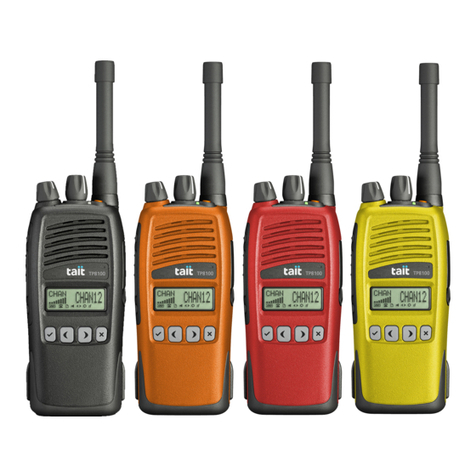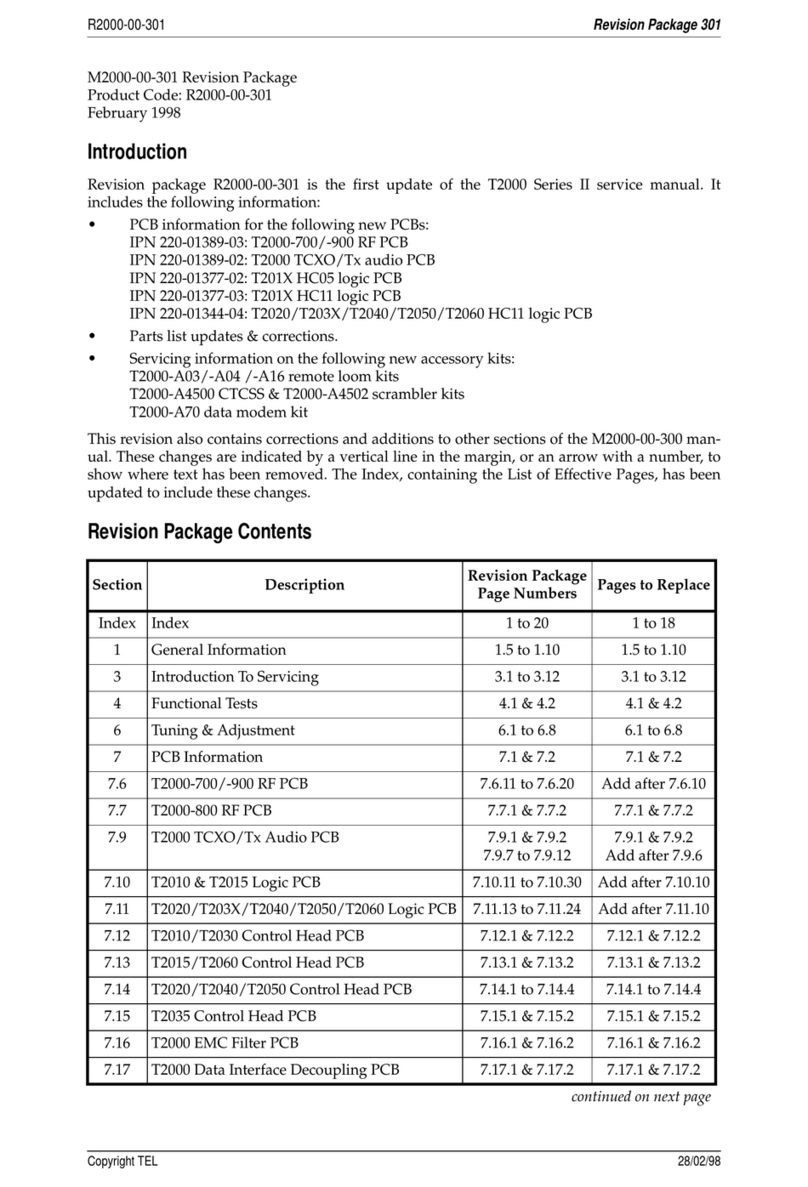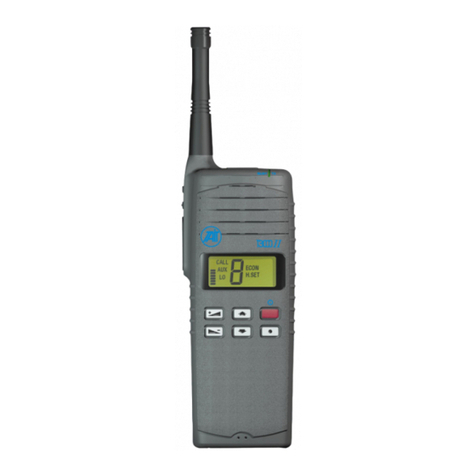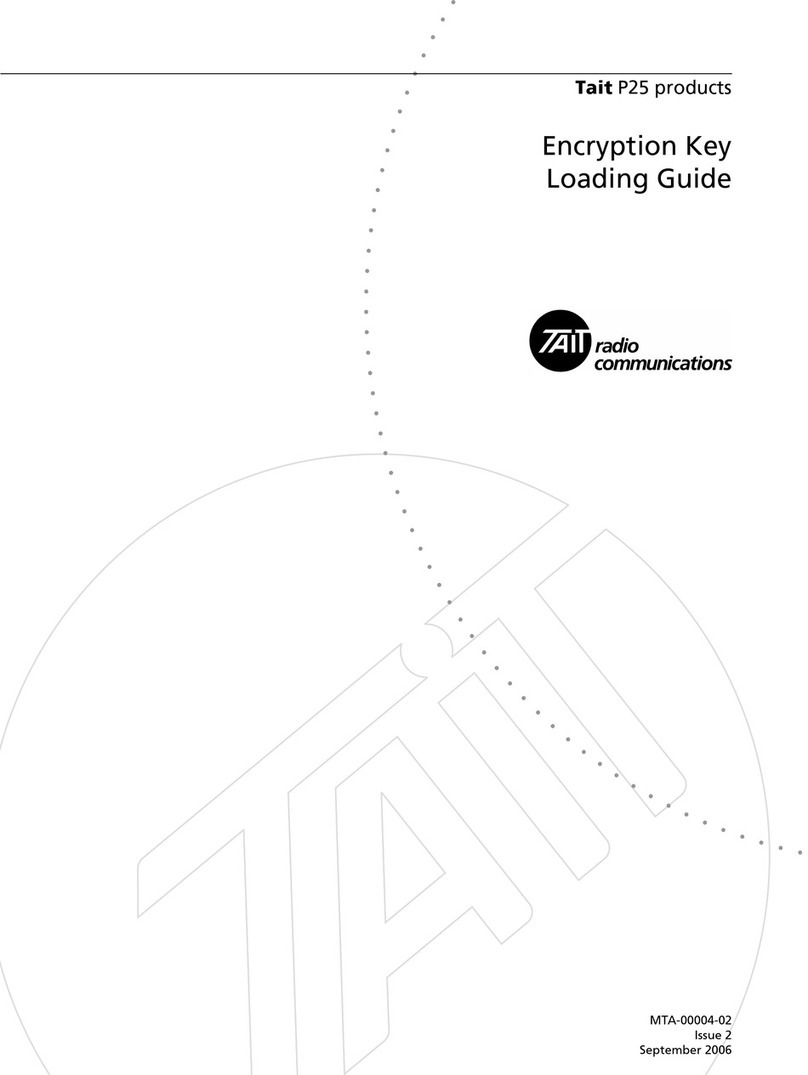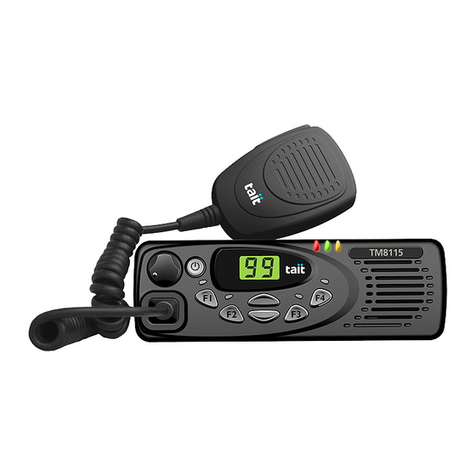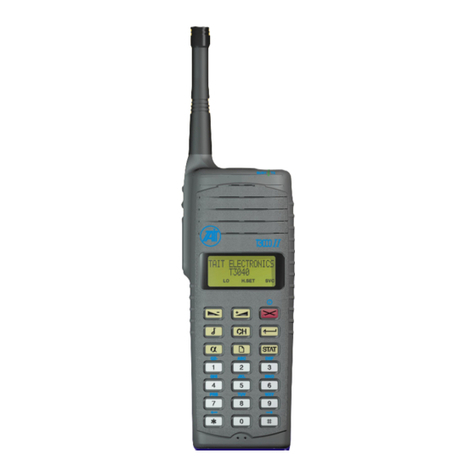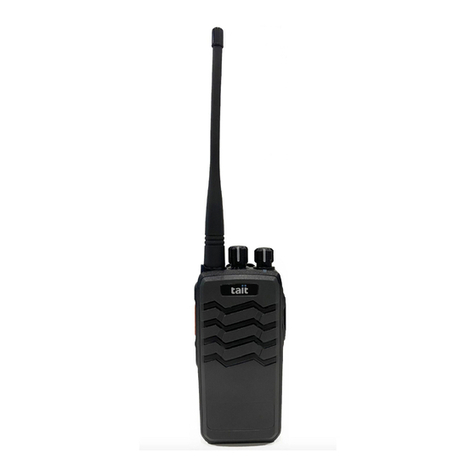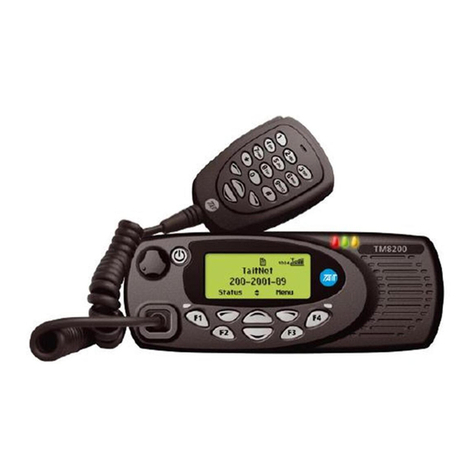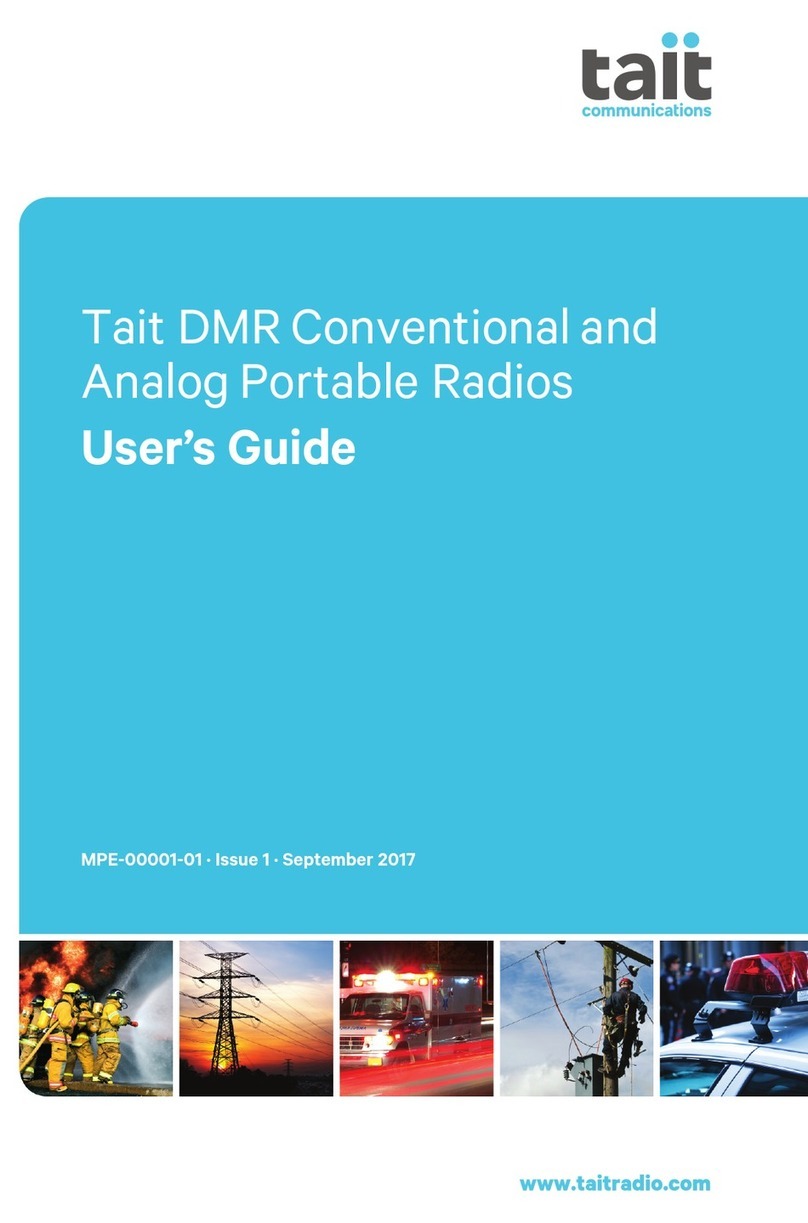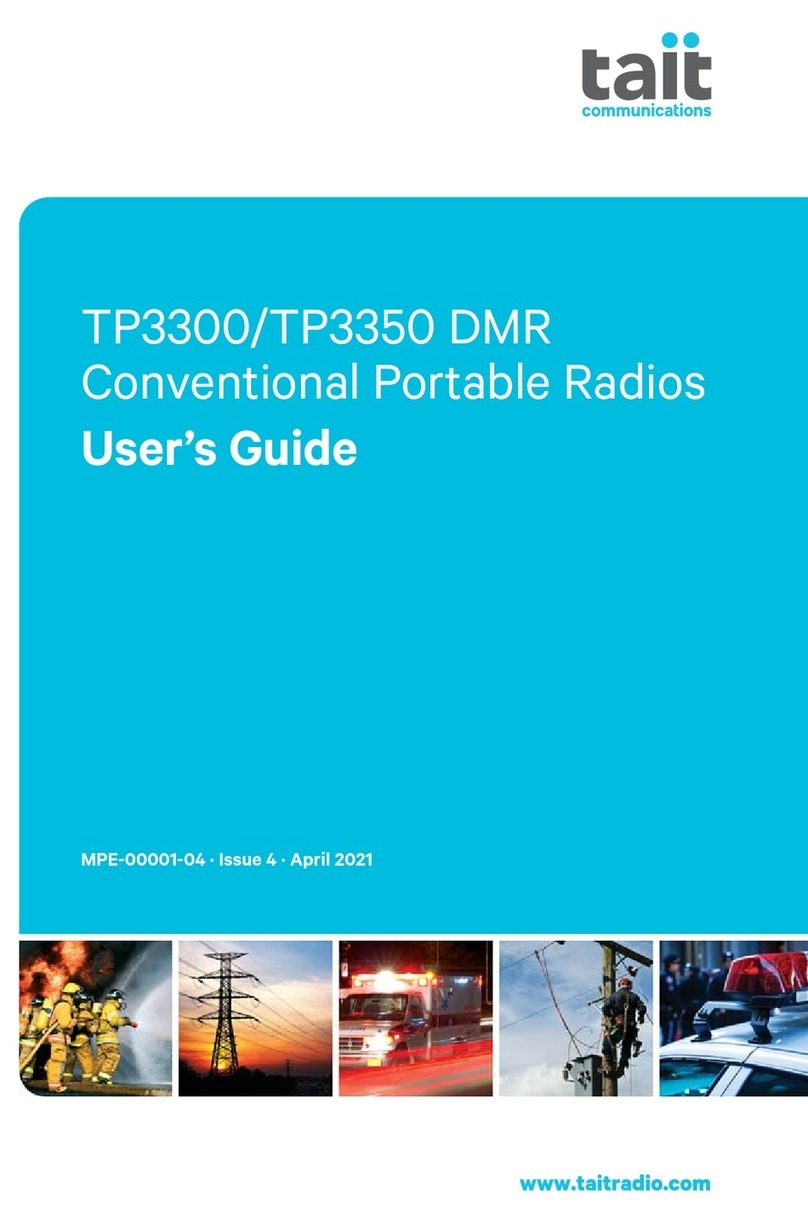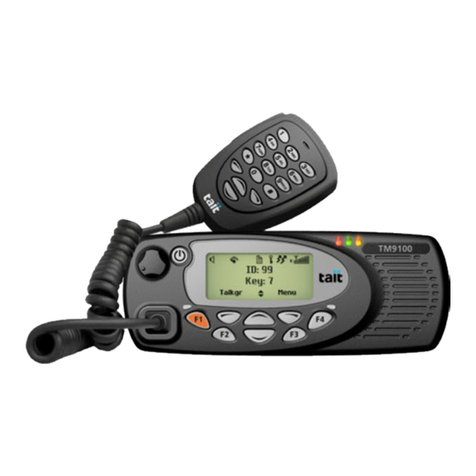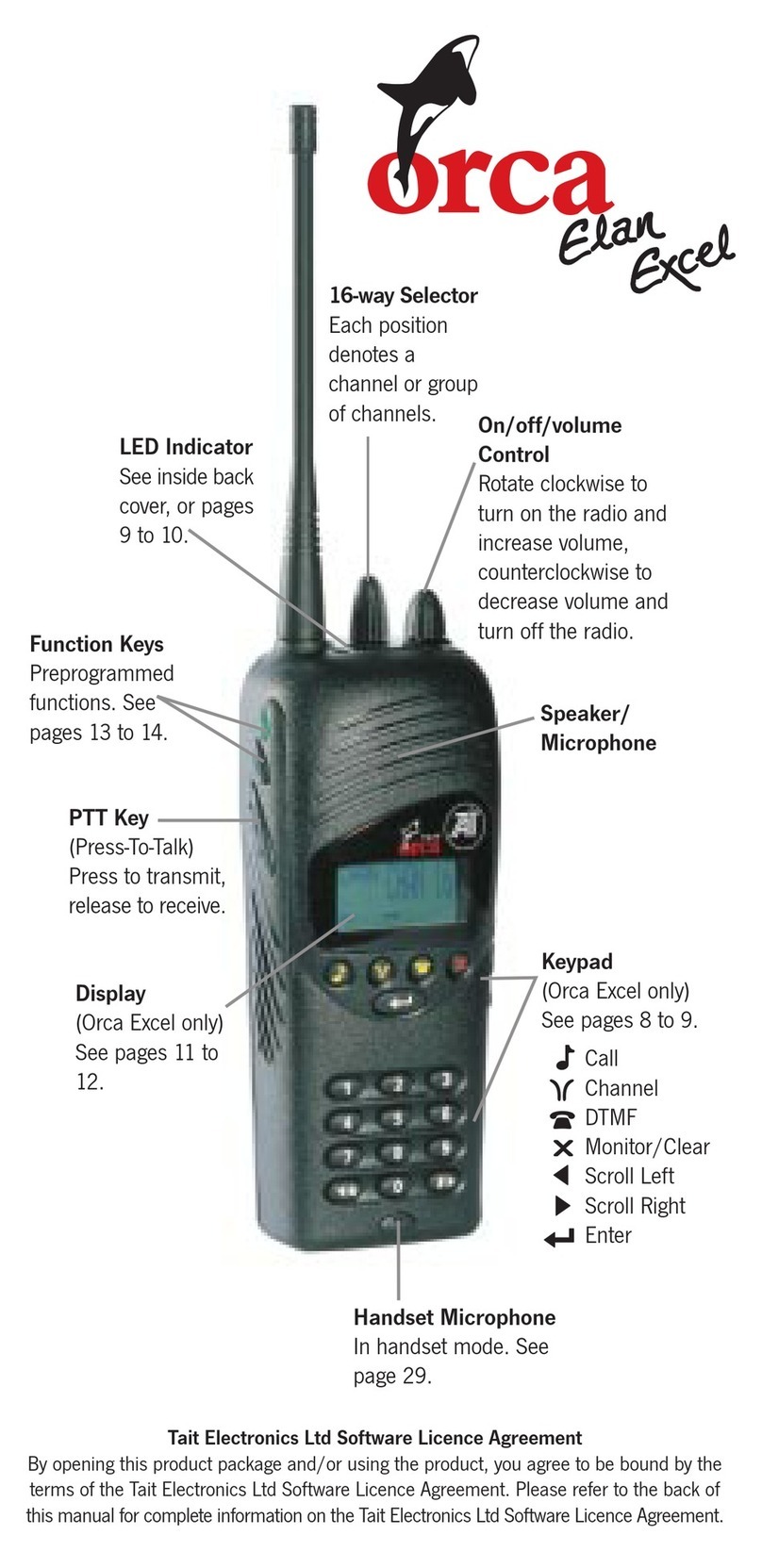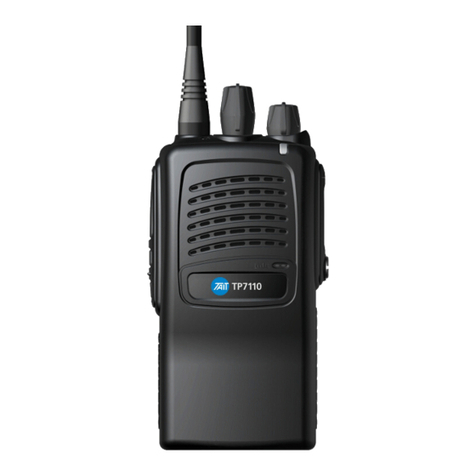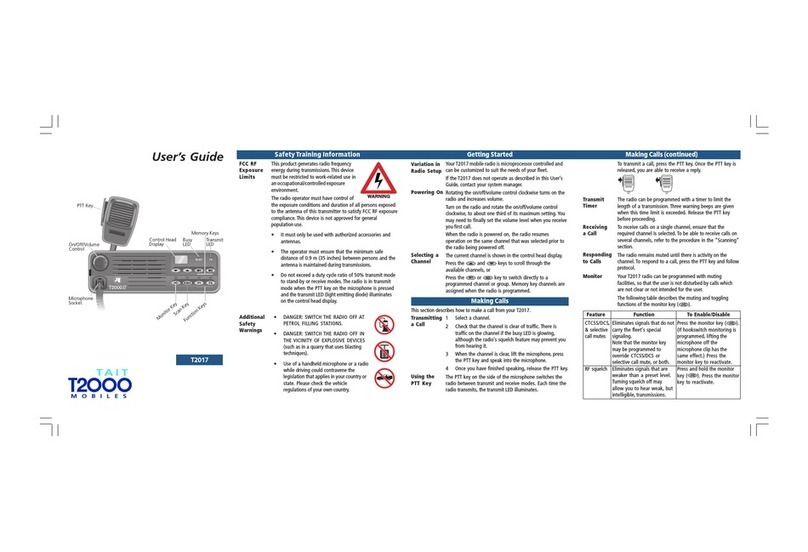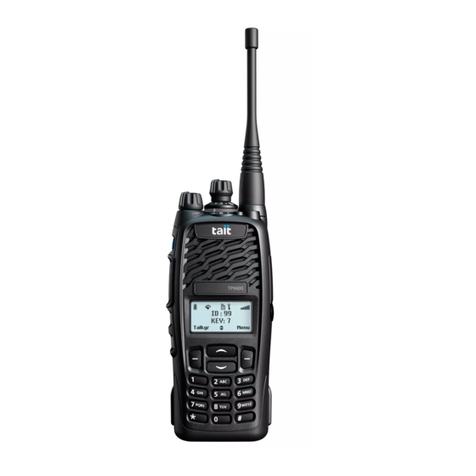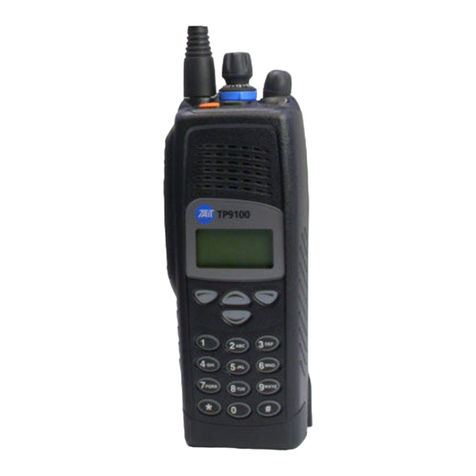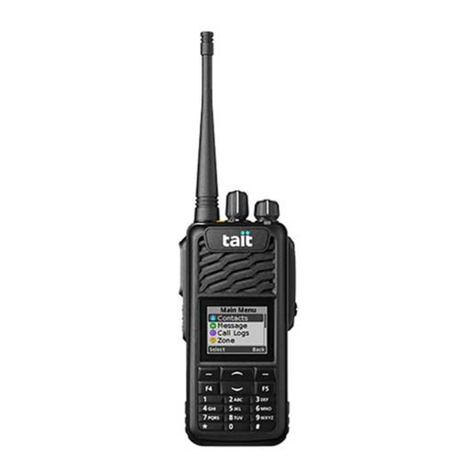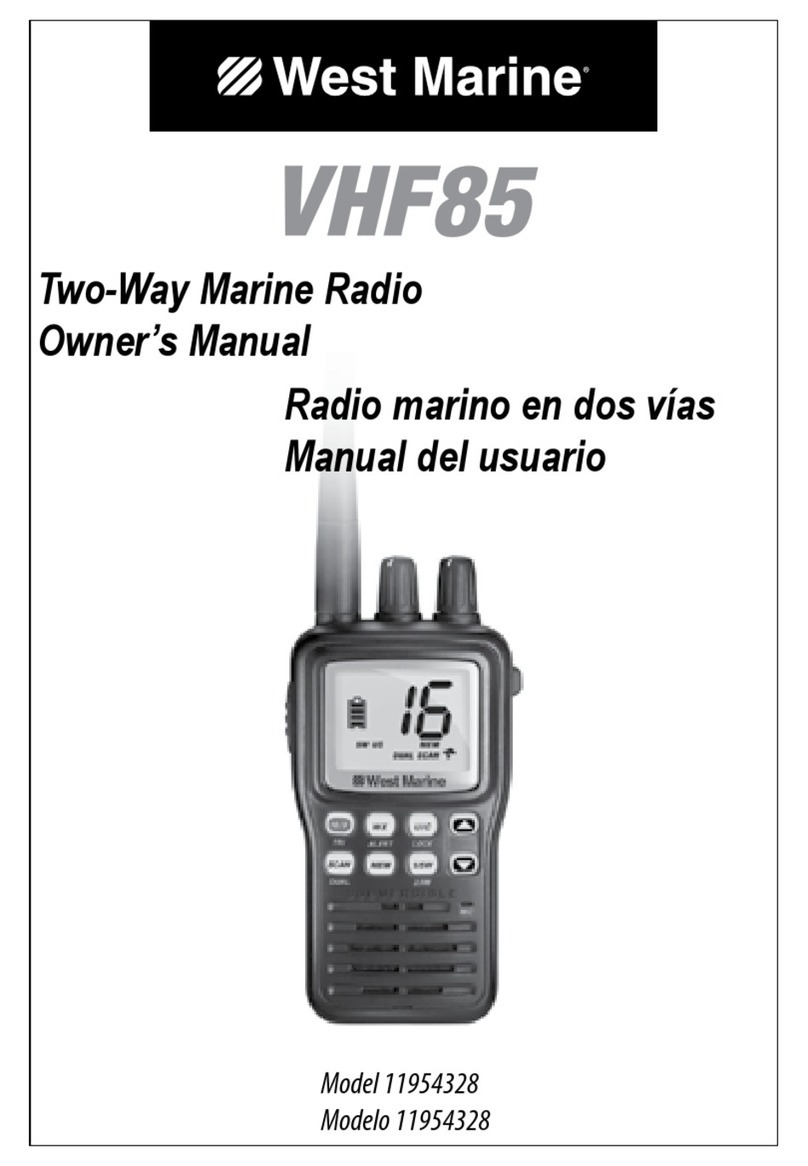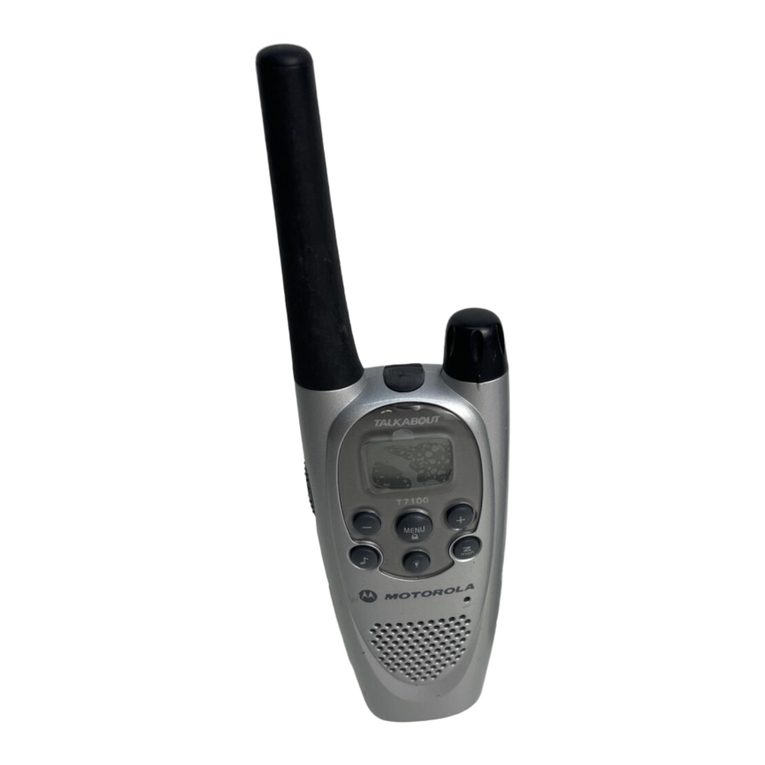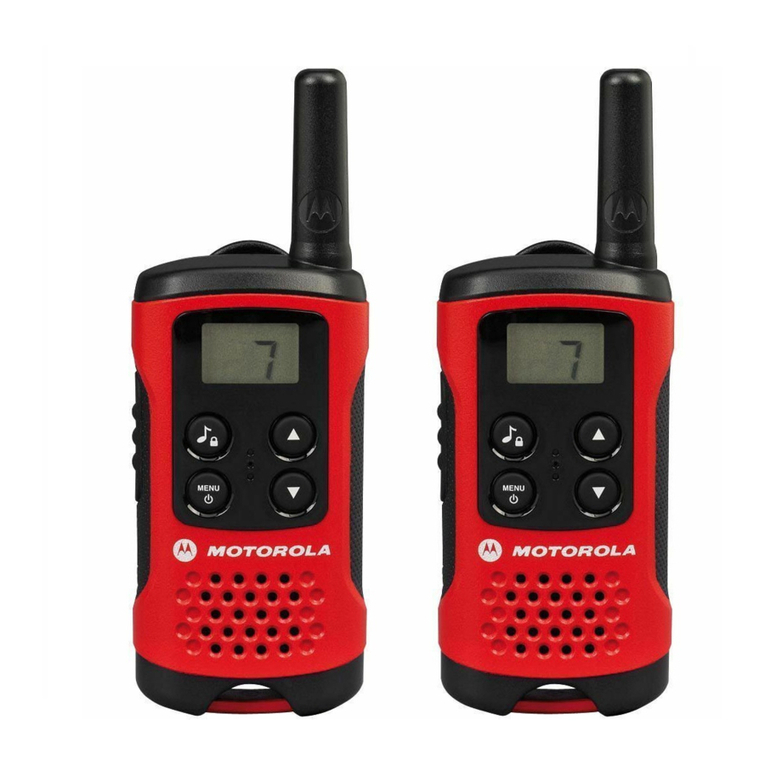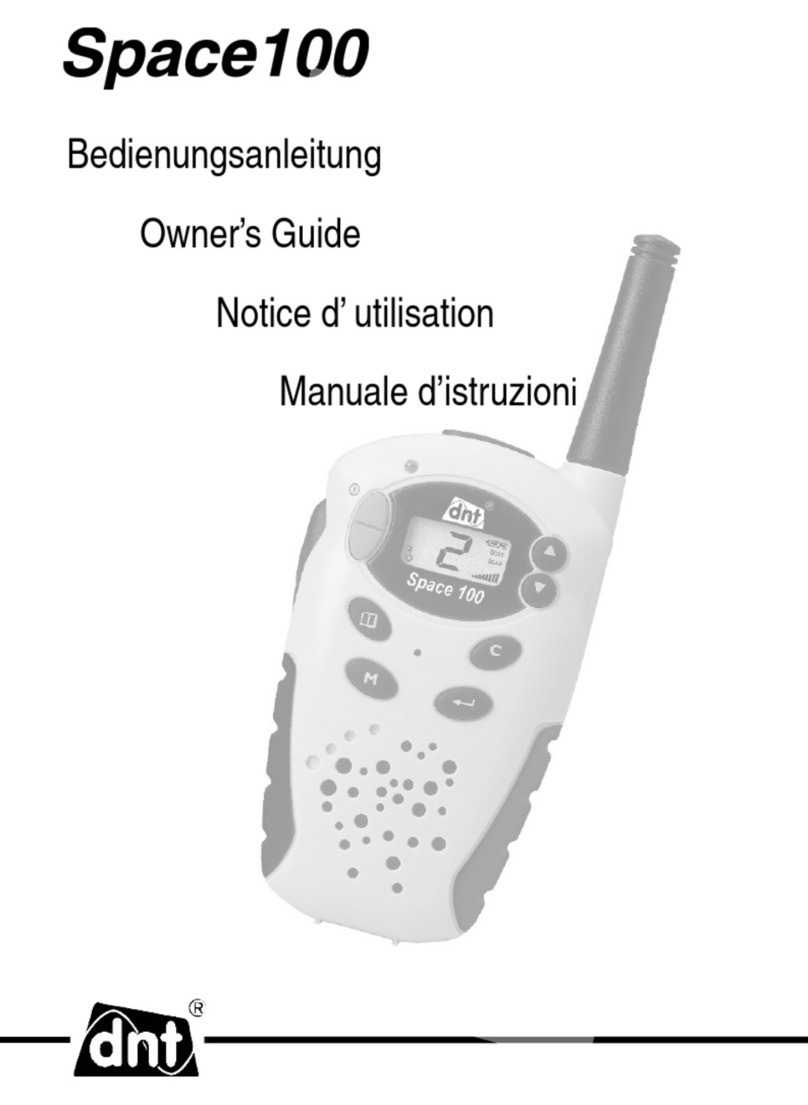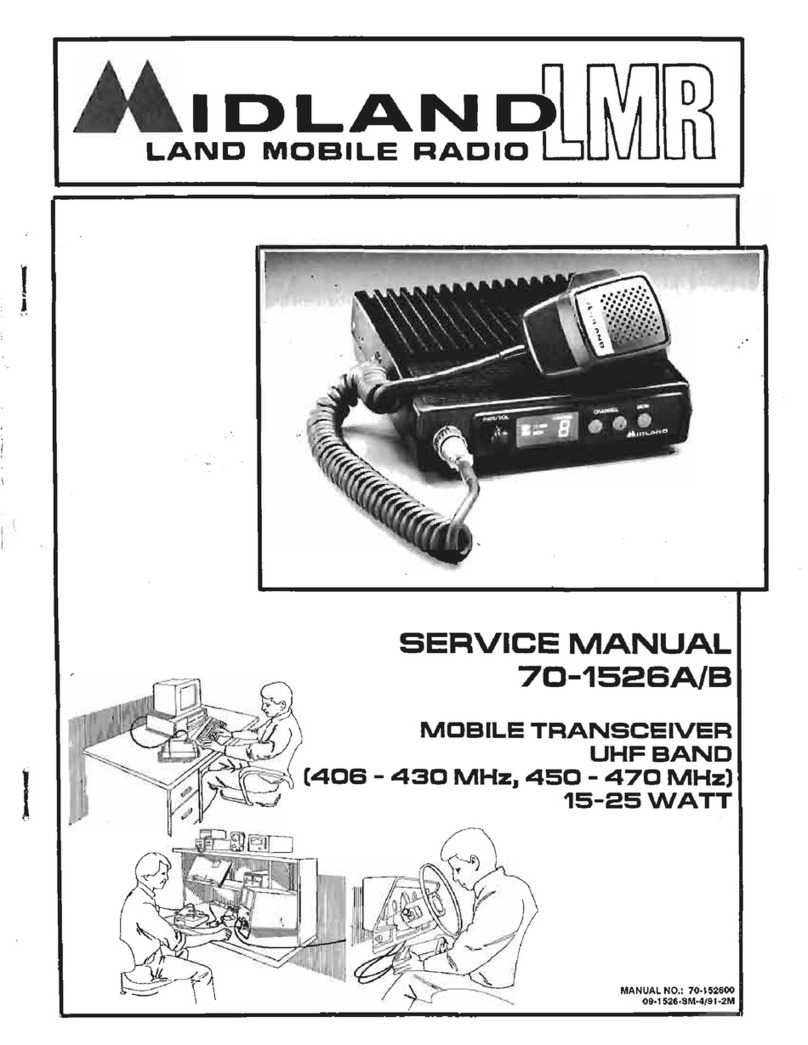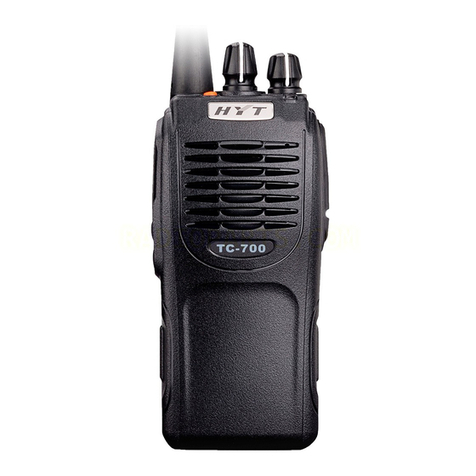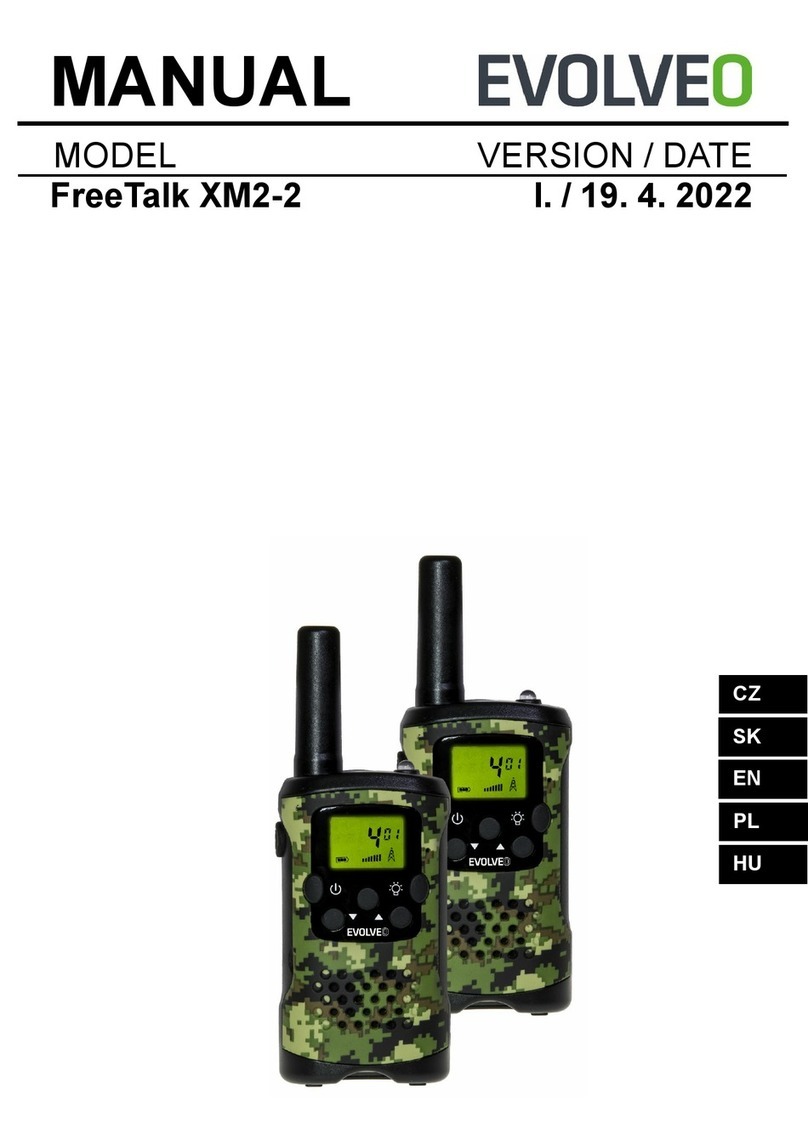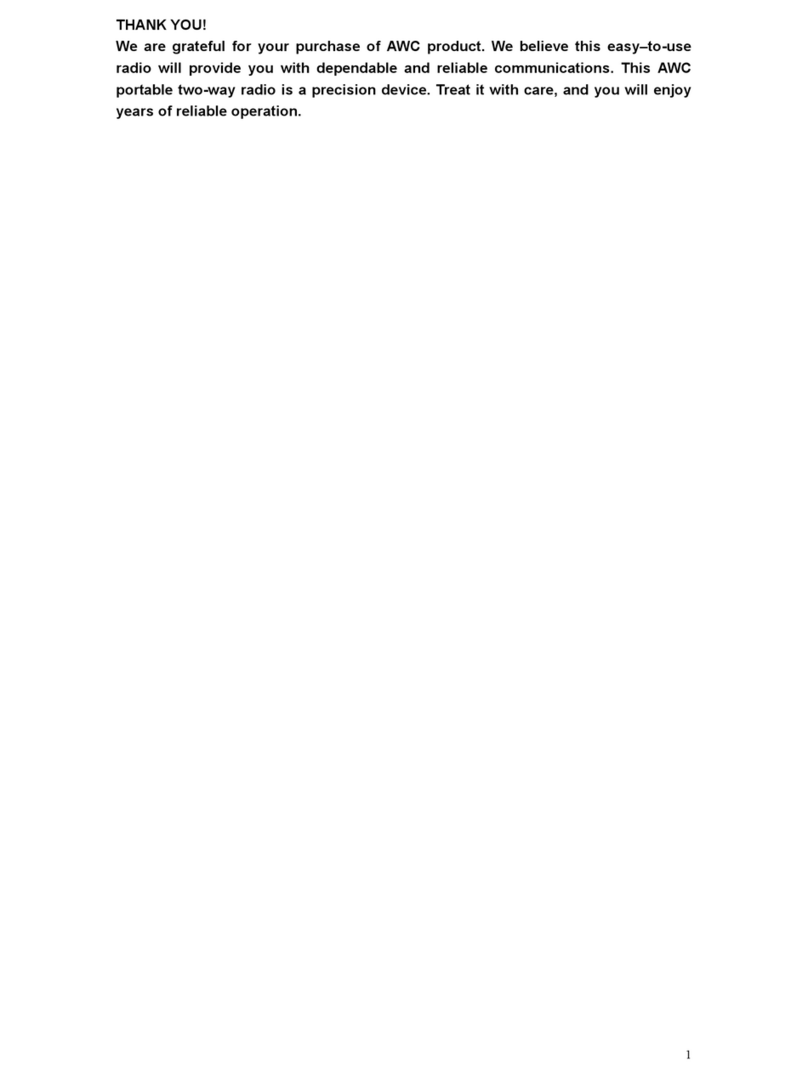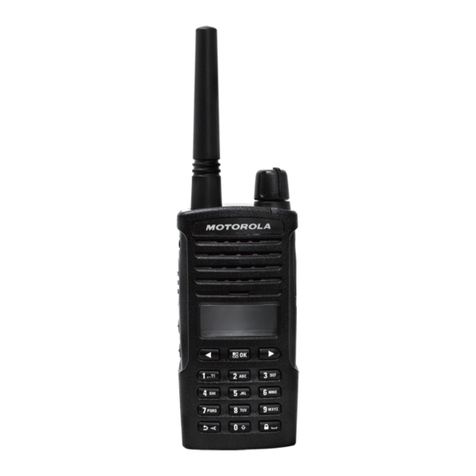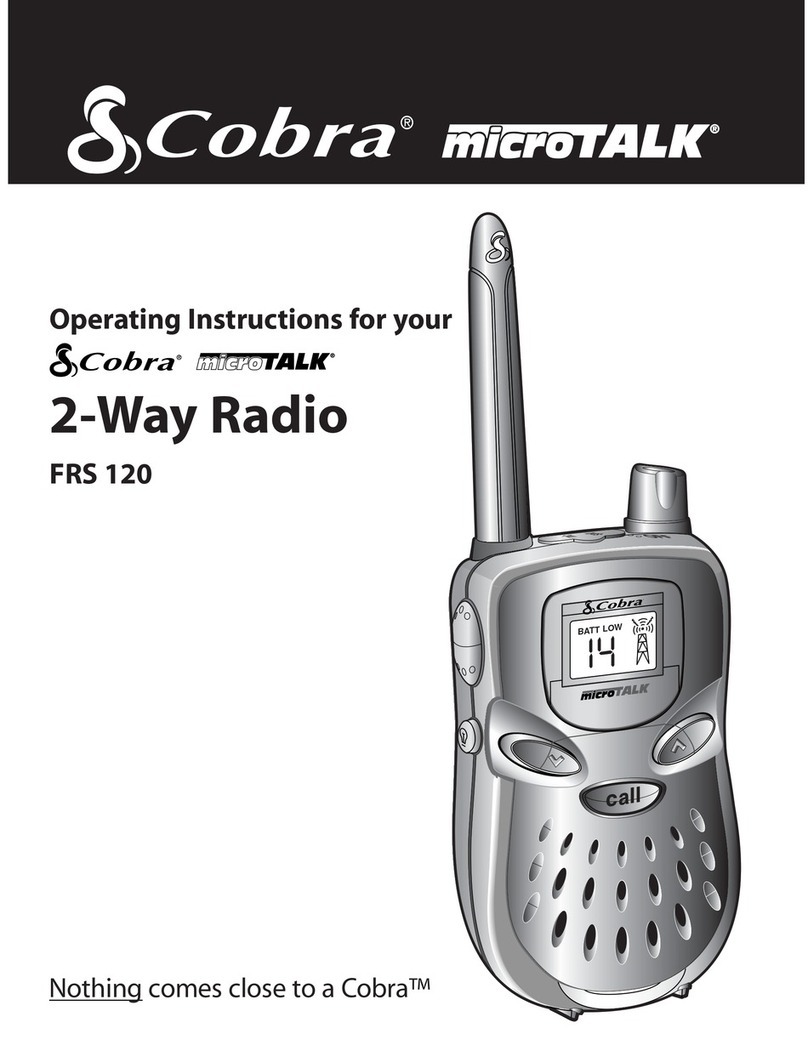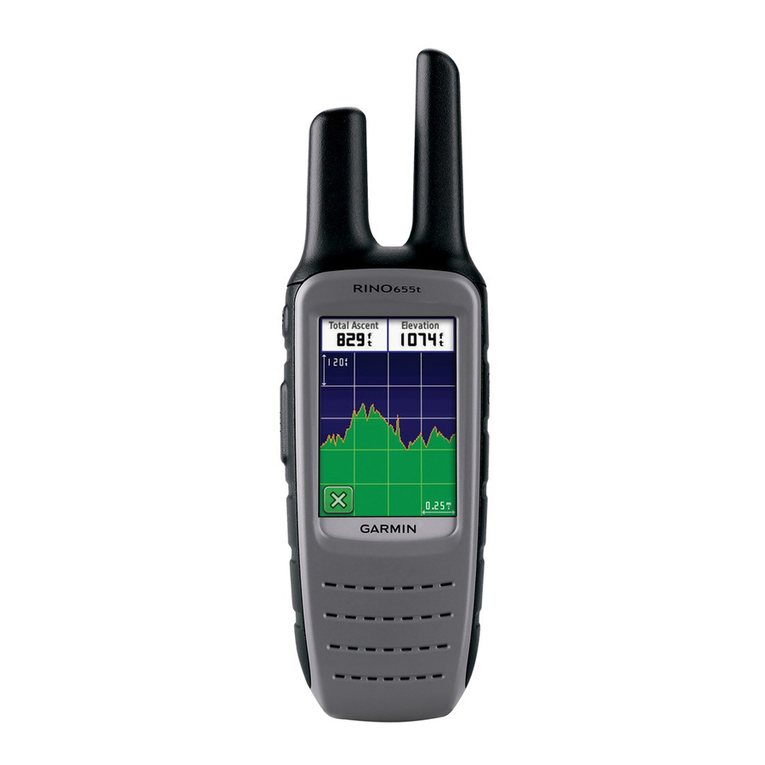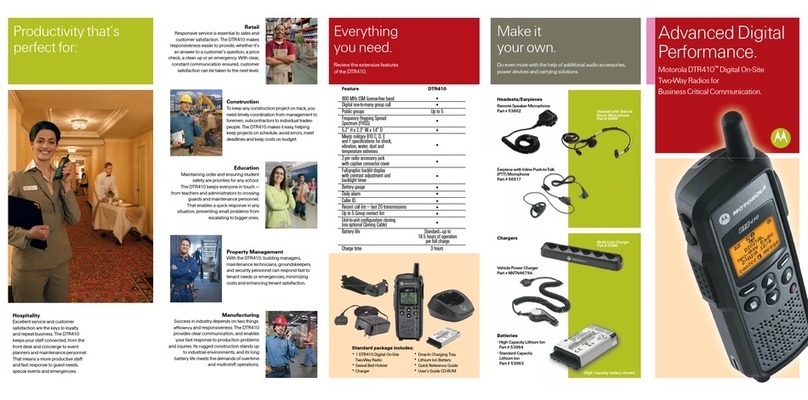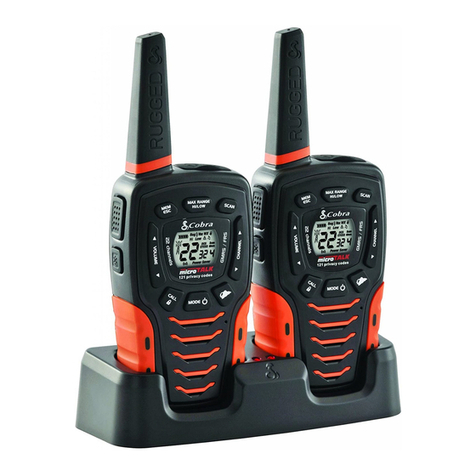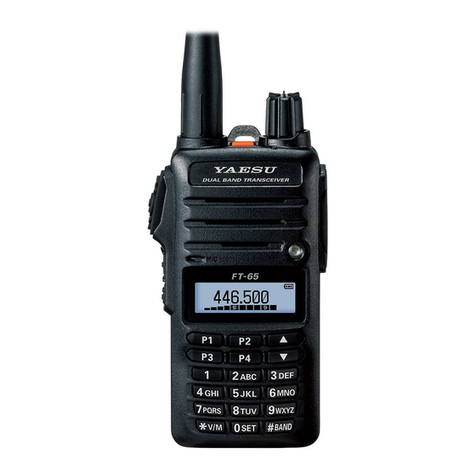Call Information
Safety Precautions
Earphones,
Palm
and Lapel
Microphones
Battery
Charger
6-Way
Multi-Charger
Battery
Antennas
Accessory
Connector Kits
D-Clip
Leather Carry Cases
Belt Loop
Car Kit
Accessory
Adaptors
Headphones
Servicing and Programming Kits
Speaker
Microphones
Accessories
Contact your authorised Tait Dealer
Keypad lock is on.
uYour radio does not require routine maintenance. However,it is a
sophisticated electronic device and should be treated with care.
uClean the radio,accessories and charger weekly using a clean dry lint-free
cloth.When cleaning, do not use solvents,detergents, alcohol,aerosol sprays
or petroleum-based products.
uClean the electrical contacts on the battery and charger weekly, using a clean
dry Q-tipTM/cotton bud.
uDo not put the radio and accessories in fluids.
uDo not drop the radio onto hard surfaces,place it down carefully.
uDo not use if the radio,antenna or accessories are damaged.
uRepairs and modifications must only be carried out by a Tait approved dealer.
uAlways have the D-Clip or protective cover installed to protect
the radio from dust ingress and electostatic discharges.
Looking after your Radio
Conventional Features
Performance
To maintain the optimum performance of the radio:
uUse only the supplied antenna.
uUse only the radio and accessories for their design purpose.
uUse only accessories that are approved by Tait Electronics Ltd.
uAvoid high temperatures.If the temperature exceeds 80ºC (176ºF) the radio
will make two short high-pitched beeps and will not work.Temperatures
above 90ºC (194ºF) cause permanent damage to the radio.
To maintain the optimum performance of the battery:
uShort condition the battery weekly.
uLong condition the battery only for the following conditions: on first use,
if performance is poor, and after more than two weeks of storage.
uTurn the radio off when it is unattended for long periods.
uClean electrical contacts of the battery and charger weekly, using a clean dry
Q-tipTM /cotton bud.
uUse only Tait Orca 5000 series battery chargers with software version 2.07+.
Recycle
Recycle batteries that are of no use.
Contact your authorised Tait dealer for advice.
Enter Security PIN code
using keypad (personal
identification number).
Long press
to unlock
Troubleshooting
If the display is blank after turning on the radio and the radio turns itself
off automatically after a few minutes,it is likely there is no power.
Fast flash. Radio is incorrectly configured.Contact your authorised
Tait dealer or your company administrator.
Contactyour authorisedTaitdealer oryour company administrator.
Low pitch beep for 10
seconds. Battery is too
lowtooperatetheradio.
Turn off the radio.
Charge the battery.
Slow flash. Low pitch
beep, short duration,
every 5 seconds.
Battery is low. Charge
the battery. High pitch beep, short duration,
two times. Temperature is too
high. Turn off the radio and allow
the radio to cool down in a cool
place.
Fast flash. High
pitch beeps. Radio
is stunned. Contact
the despatcher.
Backlighting
When you press a key, backlighting is
turnedon. It turns off after 1-10 seconds
of no activity. Set via a function key.
Handset mode
Speakervolumeisreducedsothatradio
can be held near to the ear like a
cellphone. Press PTT to talk, release
PTT to listen.
Monitor mode
Listen to all traffic and all groups on a
channel. Monitor mode automatically
turns off after a preset time.
It can be reset by the despatcher or
when some types of calls are made.
It can be configured to override Selcall
(Selcall mute) or both Selcall and
CTCSS/DCS.
Squelch Override
Thisoverridesthe squelch feature so that
all signals are made audible. This may
improve the signal reception in marginal
areas, but will likely increase noise. It
cannot be activated when a scan group
is selected. Set via a function key.
Squelch
Squelch allows reception of intellgible
signals that are above the factory-set
signal threshold, thus reducing noise.
Set via the Menu to city or country.
Night Use mode
If on, the keypad backlighting is turned
onwhenthere is activity on the channel
or if the keypad or selector is used.
Turns off after 1 to 10 seconds of no
activity. Set via the Menu.
Security
Accessory Use
Carry Case
Belt Loop
Installing
the D-clip
Note for Accessories
To use the belt loop,
the accessory needs
the D-clip fitting.
For example:a lapel
microphone.
Using the
radio,lapel
microphone
and carry
case
Remove by
peeling
apart
Install the
Belt Loop
Installing the
Radio and
Carry Case
Removing the Radio
and Carry Case
Rotate
the Carry
Case by
180
degrees
Slide the Carry
Case upwards
Unfasten
theClip and
remove the
Radio
Install
the clip
Install
the
Radio
Install
the
Carry
Case
Removing
the D-clip
Installing
the Battery
Removing
the Battery
Nuisance Delete
If a Channel in a Scan group is busy for
a long time and you do not want to
listen to the conversation, you can
temporarilyremoveitfromthe scanning
regime using Nuisance Delete.
To apply Nuisance Delete to the
currently selected Channel, press the
function key (if configured). This will
remove the currently selected Channel
from the scanning regime. Select the
Scan Group again to reset and remove
Nuisance Delete.
Flash
slow
Indicators
Radio power-up sequence
Medium pitch
beep, short
duration,twice.
Flash medium Flash slow
Mediumpitchbeep,
short duration. Low pitch beep,
short duration.
Transmit at normal power
Transmit at low power Handset mode
Function turned on Function turned off
Channel is busy
Flash medium
Monitor or Squelch Override
Slow flash = every 2 seconds
Medium flash = every 1 second
Fast flash = four per second
Flash fast
Medium pitch warble, long
duration,repeating.
Call received but not
answered or queued
Press PTT to return the call.
Medium pitch beep, long
duration, three times. Low pitch beep, for
1.5 seconds.
Lowpitch beep, longduration. Medium pitch beep,
short duration, two
times.
Call time is almost up,
10 seconds to go Transmit timer
has expired
No transmit
Channel is busy or transmit is
inhibited by Selcall muting. Wait
or use a free channel. Squelch Override
Economy mode
Flash slow
Flash
slow
Repeater talk
around (RTA)
Scan Group for
activity or greatest
signal strength Activity detected
on a Scan Group
Flash
medium
Steady
Steady
Steady
Flash fast
uIs the radio turned on?
uIs the correct channel selected?
uIs the battery installed on the radio?
uIs the battery charged?
uIs the antenna damaged?
uIs the battery charger working properly?
Checklist
Standard Mode
Users on the same
Channel can hear
the message.
Repeater
CTCSS/DCS Mode
Sub-audible tones
enable specific
calls to Channels
or Groups.
Receive Receive Ignore
Repeater
Selcall Mode
Audible tones (beeps)
enable selective calls
to be made to
Individuals or Groups.
Receive
Repeater
Acknowledgement and status received
from recipient of call.
No Acknowledge. Recipient has not
acknowledged your call.
FCC RF Exposure Limits
This product generates radio frequency energy during transmissions. It
is classified by the FCC as suitable for general population use in an
uncontrolled exposure environment.The following conditions apply
to the use of this radio:
uIt must only be used with authorised accessories and antennas.
uDo not exceed a duty cycle ratio of 20% transmit mode to stand-by or receive modes.
The radio is in transmit mode when the PTT key on the radio is pressed and the TX
indicator LED is lit.
Additional Safety Precautions:
uWhen transmitting, hold the radio microphone 25–50mm (1–2 inches) from your mouth.
uWhen transmitting, keep the antenna at least 25mm (1 inch) from any part of your
body, especially your face and eyes.
uTurn off the radio where radio waves could interfere with electronic devices.
uTurn off the radio at fuel/gas stations.
uTurn off the radio in an area where detonators/explosives are being used.
uTurn off the radio before boarding/leaving an aircraft and whilst on board an aircraft.
uDo not use the radio whilst driving vehicles or operating machinery.
uDo not use earphones or headsets at high volume levels.
uDo not transmit in frequency bands that are reserved for use by distress beacons, such
as 406 to 406.1 MHz.
uDo not put the radio,battery or accessories in liquids as they will be damaged.
uDo not allow children to play with the radio; it is not a toy.
Hazardous Atmospheres
A hazardous atmosphere has the potential for fire or explosion from dusts,gases, liquids
and solids.Make sure of the following in hazardous atmospheres:
uTurn off the radio, unless the radio is qualified for use in hazardous atmospheres.
uDo not replace batteries,even if the radio is qualified for use in hazardous atmospheres.
uDo not use damaged radios.If the radio was originally qualified for use in such
environments,the radio is not qualified if it has a cracked casing.
uDo not modify the configuration of a radio that is qualified as intrinsically safe for use
in hazardous atmospheres.If you do, it will not be qualified.
Electromagnetic Interference
Turn off your radio where radio waves could interfere with electronic devices. Some facilities
use equipment that is sensitive to Electromagnetic Interference such as: hospitals, medical
centres,aircraft and some industrial facilities. Only use your radio in these situations if the
radio is qualified for use in such areas.
